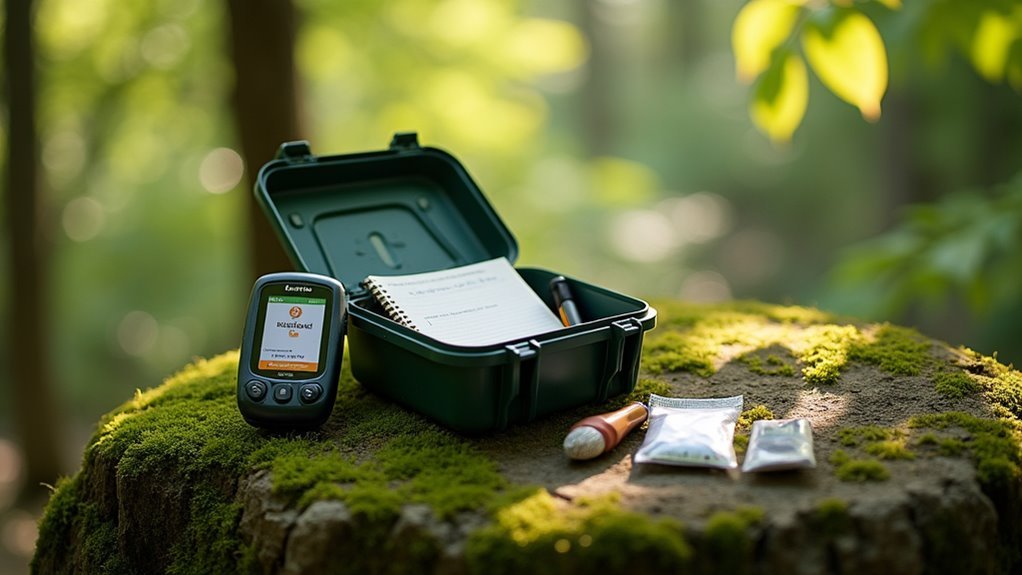Some of the links in this article may be affiliate links. If you make a purchase through these links, we may earn a small commission at no extra cost to you. Thank you.
Picture a once-vibrant geocache container now damp and forgotten, its logbook a soggy mess that disappoints enthusiastic treasure hunters. I’ve been there—both as the disappointed finder and the negligent owner who let maintenance slide. Your cache is your reputation in the geocaching community, and I’ve learned the hard way that regular upkeep isn’t just courtesy—it’s essential. Want to know the secrets to keeping your hides in pristine condition without spending hours on maintenance? The techniques might surprise you.
Understanding the Geocache Health Score System

The Health Score system lurking behind your geocaches is something I’ve learned to take pretty seriously.
It’s basically Groundspeak’s way of monitoring whether your cache might need some TLC, using an automated calculation based on logs and other factors.
Geocaching’s Health Score system keeps tabs on your caches, calculating when they might need a little maintenance love.
When geocachers post DNFs or Needs Maintenance logs, your cache’s Health Score takes a hit.
Once it drops below a certain threshold—which I think happens pretty quickly, since even tough D5 caches can trigger warnings after just 2-3 DNFs—you’ll receive an automated email suggesting maintenance.
The thing is, reviewers actually use this score during their sweeps, so it’s not just some arbitrary number.
It’s a real indicator that, well, your cache might need your attention soon.
Essential Tools for Geocache Maintenance
A well-stocked maintenance kit has honestly saved my bacon more times than I can count when checking up on my caches. When you arrive at your hide and discover your cache container is damaged, you’ll thank yourself for being prepared.
| Essential Item | Why You Need It |
|---|---|
| Extra logbooks | Replaces wet or full logs during inspections |
| Backup containers | Quick swap when the original is damaged |
| Replacement papers | Keeps contents dry after finding waterlogged logs |
| SWAG check tools | Verifies items are safe and appropriate |
| CITO bags | Helps clean the surrounding area during regular maintenance |
I’ve learned through experience that regular maintenance isn’t just about the cache itself—it’s also about preserving the environment around it. Trust me, geocachers notice and appreciate a well-maintained hide!
Responding to Logs and Community Feedback

Why do geocache logs matter so much to cache owners?
Well, they’re basically your lifeline to knowing how your cache is doing out there in the wild.
When someone posts a DNF, it’s my signal to check on things—maybe the cache has wandered off or needs some TLC.
I always respond quickly to Needs Maintenance logs.
Once I’ve fixed whatever issue was reported—soggy logbook, missing pencil, you name it—I post an Owner Maintenance log to let everyone know it’s good to go again.
The Health Score is like a report card for your cache maintenance habits.
If it drops low, you’ll get an email nudging you to take action.
Trust me, staying on top of logs keeps your cache in great shape!
Physical Cache Inspection and Repairs
Responding to logs is just part of being a responsible cache owner—now let’s talk about getting your hands dirty with actual inspections.
Regular cache maintenance is essential to guarantee that your geocache stays in good condition for future seekers.
When I visit my caches, I always follow these steps:
- Visit coordinates regularly to check for damage or signs of mugging
- Carry backup containers to replace cracked or broken ones on the spot
- Replace logbooks every couple months, especially if they’re wet or full
- Check SWAG items and remove anything that’s damaged or inappropriate
- Verify trackable inventory and mark missing items, while also doing some CITO
I think of my caches like little outdoor pets—they need regular check-ups to stay healthy!
You’ll be surprised how quickly the elements can affect even the sturdiest containers.
Managing Trackables and Cache Contents

Trackables and swag items are the treasures that make geocaching feel like a real adventure!
When I’m doing cache maintenance, I always verify my inventory by physically checking each trackable.
If something’s missing, I mark it on the geocaching platform right away—it’s only fair to let the community know.
Logbooks get gross pretty quickly, especially in wet areas.
I actually—wait, not actually—I just carry extra logbooks and replace them every couple months.
Trust me, nobody wants to sign a soggy mess!
Don’t forget to inspect the SWAG too.
Part of good geocache maintenance is ensuring those little trinkets remain in decent condition.
After all, finding cool little treasures is what makes finding a cache so exciting for many people!
Preventing Common Maintenance Issues
Preventing common maintenance issues begins with anticipation rather than reaction.
I’ve learned through years of cache maintenance that staying ahead of problems saves time and protects your Health Score.
You know, it’s like checking your oil before a road trip rather than waiting for the engine light!
Here’s my prevention checklist:
- Inspect containers quarterly, especially in rainy areas where logbooks get soggy fast
- Monitor cache logs weekly for early warning signs from seekers
- Use high-quality, truly waterproof containers—not just water-resistant ones
- Carry backup supplies during your own cache visits for immediate fixes
- Keep your cache page updated with accurate coordinates and helpful hints
I think these simple steps will help your caches stay in great condition year-round.
Frequently Asked Questions
How to Properly Maintain a Geocache?
Like a lighthouse keeper, I’ll help you maintain your geocache. Regular cache inspection keeps everything shipshape—use weatherproof containers, replace logs when damp, update online info, and check SWAG items during visits.
Is Geocaching Still a Thing in 2025?
Yes, I’ve seen geocaching remain strong in 2025! Global resurgence is happening with active forums and recent updates. Popularity trends suggest its future appeal continues to captivate adventurous spirits worldwide.
What Is a Ghost Geocache?
I’ve heard of ghost caches when listings remain online but physically vanish. Unlike cache myths or phantom legends, these are real problems causing frustration when you’re searching for something that’s no longer there.
What Does GZ Mean When Geocaching?
When I reached the park bench coordinates, I’d found GZ! In geocaching, GZ means “Ground Zero”—the Finder Symbols indicating exactly where the cache is hidden. The Acronym Usage originated from navigation terminology.